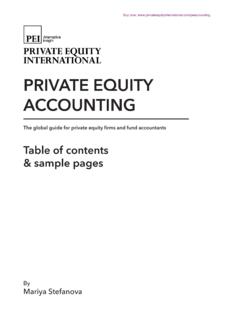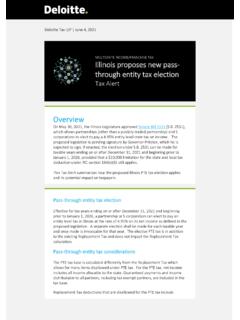Transcription of Part I § 704; 1.704-1; 1.704-3.) Rev. Rul. 2004-49 ISSUE
1 Part I Section of Goodwill and Certain Other Intangibles 26 CFR : Amortization of goodwill and certain other intangibles. (Also ' 704; ; ) Rev. Rul. 2004-49 ISSUE If, pursuant to (b)(2)(iv)(f) of the Income Tax Regulations, a partnership revalues a section 197 intangible, may the partnership allocate amortization with respect to the section 197 intangible so as to take into account the built-in gain or loss from the revaluation? FACTS Situation 1. A and B are partners in the AB partnership . C contributes money (more than a de minimis amount) to the partnership in exchange for a partnership interest. The partnership revalues the assets of the partnership under (b)(2)(iv)(f). The AB partnership owns several assets, including Asset 1, a section 197 intangible. Asset 1 is amortizable in the hands of the partnership . A, B, and C are not related.
2 Situation 2. Situation 2 is the same as Situation 1 except that Asset 1 is not amortizable in the hands of the partnership . LAW Section 197(a) provides that a taxpayer is entitled to an amortization deduction with respect to any amortizable section 197 intangible. The amount of the deduction is determined by amortizing the adjusted basis (for purposes of determining gain) of the intangible ratably over the 15-year period beginning with the month in which the intangible was acquired. Section 197(c)(1) provides that, with certain exceptions, the term amortizable section 197 intangible means any section 197 intangible, (A) that is acquired by the taxpayer after the date of the enactment of 197, and (B) that is held in connection with the conduct of a trade or business or an activity described in 212. 2 Section 197(d)(1) provides that the term section 197 intangible means (A) goodwill; (B) going concern value; (C) any of the following intangible items: (i) workforce in place including its composition and terms and conditions (contractual or otherwise) of its employment, (ii) business books and records, operating systems, or any other information base (including lists or other information with respect to current or prospective customers), (iii) any patent, copyright, formula, process, design, pattern, knowhow, format, or other similar items, (iv) any customer-based intangible, (v) any supplier-based intangible, and (vi) any other similar item; (D) any license, permit, or other right granted by a governmental unit or an agency or instrumentality thereof.
3 (E) ) any covenant not to compete (or other arrangement to the extent the arrangement has substantially the same effect as a covenant not to compete) entered into in connection with an acquisition (directly or indirectly) of an interest in a trade or business or substantial portion thereof; and (F) any franchise, trademark, or trade name. Under 197(f)(9)(A), the term amortizable section 197 intangible does not include any section 197 intangible that is goodwill or going concern value (or for which depreciation or amortization would not have been allowable but for 197) and that is acquired by the taxpayer after the date of the enactment of 197, if (i) the intangible was held or used at any time on or after July 25, 1991, and on or before such date of enactment by the taxpayer or a related person, (ii) the intangible was acquired from a person who held such intangible at any time on or after July 25, 1991, and on or before such date of enactment, and, as part of the transaction, the user of such intangible does not change, or (iii) the taxpayer grants the right to use such intangible to a person (or a person related to such person)
4 Who held or used such intangible at any time on or after July 25, 1991, and on or before such date of enactment. An intangible described in 197(f)(9) (a section 197(f)(9) intangible) is treated as an amortizable section 197 intangible only to the extent permitted under (h). The purpose of the anti-churning rules of 197(f)(9) and (h) is to prevent the amortization of section 197(f)(9) intangibles unless they are transferred after the applicable effective date in a transaction giving rise to a significant change in ownership or use. Section (h)(1)(ii). Section (h)(12) provides special rules that apply for purposes of determining whether transactions involving partnerships give rise to a significant change in ownership or use. Under (h)(5), a section 197(f)(9) intangible may be amortized by the acquirer of the intangible if the intangible was an amortizable section 197 intangible in the hands of the seller (or transferor), but only if the acquisition transaction and the transaction in which the seller (or transferor) acquired the intangible or interest therein are not part of a series of related transactions.
5 Under 704(b), a partner s distributive share of income, gain, loss, deduction, or credit (or item thereof) is determined in accordance with the partnership agreement provided that those allocations have substantial economic effect. If the allocations under the partnership agreement do not have substantial economic effect or the 3 partnership agreement does not provide as to a partner s distributive shares of partnership items, then the partner s distributive share of such items is determined in accordance with the partner s interest in the partnership (determined by taking into account all facts and circumstances). Section (b) describes various requirements that must be met for partnership allocations to have substantial economic effect. Among these requirements is that (except as otherwise provided in (b)) the partnership agreement must provide for the determination and maintenance of capital accounts in accordance with the rules of (b)(2)(iv).
6 Section (b)(2)(iv)(f) provides that, if certain criteria are met, the capital account maintenance rules of (b)(2)(iv) will not be violated if a partnership agreement, upon the occurrence of certain events, increases or decreases the capital accounts of the partners to reflect a revaluation of partnership property (including intangibles such as goodwill) on the partnership s books. Section 704(c)(1)(A) provides that, under regulations prescribed by the Secretary, income, gain, loss, and deduction with respect to property contributed to the partnership by a partner shall be shared among the partners so as to take account of the variation between the basis of the property to the partnership and its fair market value at the time of contribution. Section provides rules applicable to partnership allocations under 704(c)(1)(A). Section (a)(1) provides that allocations under 704(c)(1)(A) must be made using a reasonable method that is consistent with the purpose of 704(c).
7 Section describes three allocation methods that are generally reasonable: the traditional method, the traditional method with curative allocations, and the remedial allocation method. Section (a)(6)(i) provides that the principles of apply to allocations with respect to property for which differences between book value and adjusted tax basis are created when a partnership revalues partnership property pursuant to (b)(2)(iv)(f) (reverse 704(c) allocations). Partnerships are not required to use the same allocation method for reverse 704(c) allocations as for contributed property, even if at the time of revaluation the property is already subject to 704(c)(1)(A) and Section (g)(4)(i) provides that, to the extent that an intangible was an amortizable section 197 intangible in the hands of the contributing partner, a partnership may make allocations of amortization deductions with respect to the intangible to all of its partners under any of the permissible methods described in the regulations under 704(c).
8 4 Section (g)(4)(ii) provides that, to the extent that an intangible was not an amortizable section 197 intangible in the hands of the contributing partner, the intangible is not amortizable by the partnership . However, if a partner contributes a section 197 intangible to a partnership and the partnership adopts the remedial allocation method for making 704(c) allocations of amortization deductions, the partnership generally may make remedial allocations of amortization deductions with respect to the contributed section 197 intangible in accordance with (d). Section (h)(12)(vii)(A) provides that the anti-churning rules do not apply to curative or remedial allocations of amortization with respect to a section 197(f)(9) intangible if the intangible was an amortizable section 197 intangible in the hands of the contributing partner (unless (h)(10) causes the intangible to cease to be an amortizable section 197 intangible in the hands of the partnership ).
9 Section (h)(12)(vii)(B) provides that, if a section 197(f)(9) intangible was not amortizable in the hands of the contributing partner, a non-contributing partner generally may receive remedial allocations of amortization under 704(c) that are deductible for federal income tax purposes. However, such a partner may not receive remedial allocations of amortization under 704(c) if that partner is related to the partner that contributed the intangible or if, as part of a series of related transactions that includes the contribution of the section 197(f)(9) intangible to the partnership , the contributing partner or related person (other than the partnership ) becomes (or remains) a direct user of the contributed intangible. Under (h)(12)(vii)(B), taxpayers may use any reasonable method to determine amortization of the asset for book purposes, provided that the method used does not contravene the purposes of the anti-churning rules.
10 ANALYSIS If, under (b)(2)(iv)(f), a partnership revalues a section 197 intangible that is amortizable in the hands of the partnership , then the partnership may make allocations of amortization deductions with respect to the built-in gain or loss from the revaluation ( , the increase or decrease, respectively, in the book value of the intangible as a result of the revaluation) to all of its partners under any of the permissible methods described in If the revalued section 197 intangible is not amortizable in the hands of the partnership , then (g)(4)(ii) and (h)(12)(vii) generally prevent the partnership from allocating amortization with respect to the intangible under (a)(6)(i), but do not prevent the partnership from making remedial allocations of amortization with respect to the intangible. However, remedial allocations of amortization with respect to built-in gain or loss from the revaluation of a section 197(f)(9) intangible are not allowed to the extent that such allocations are, in substance, the equivalent of a remedial allocation of amortization to a partner that is related to the contributing partner (with respect to the revaluation).

















